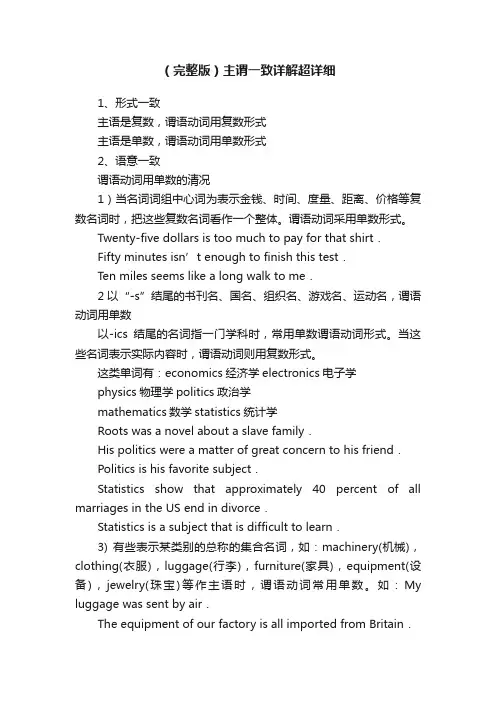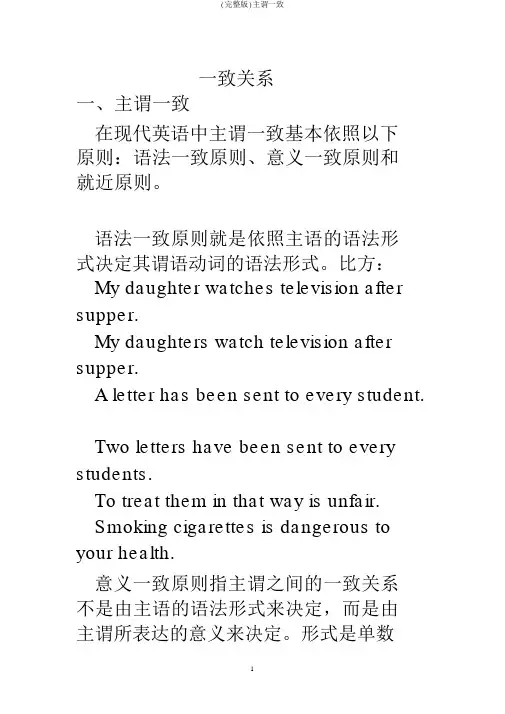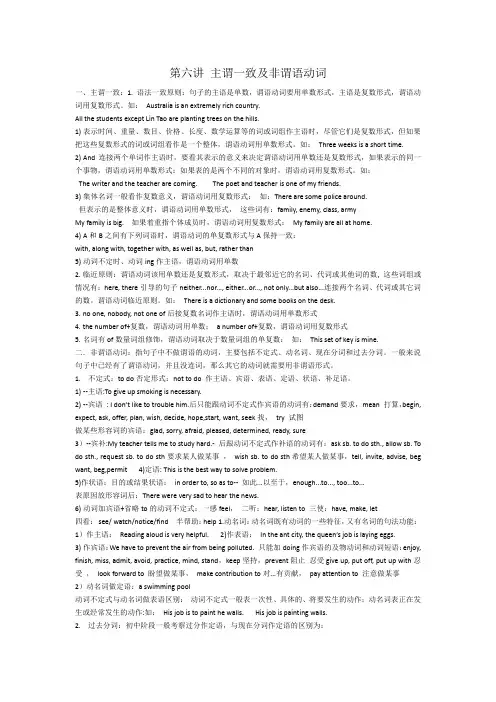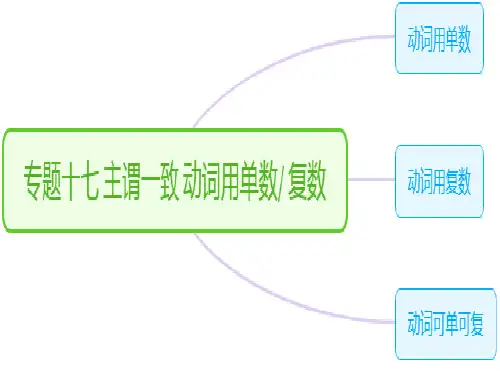第六讲 主谓一致最新修正版
- 格式:docx
- 大小:242.73 KB
- 文档页数:6

(完整版)主谓一致详解超详细1、形式一致主语是复数,谓语动词用复数形式主语是单数,谓语动词用单数形式2、语意一致谓语动词用单数的清况1)当名词词组中心词为表示金钱、时间、度量、距离、价格等复数名词时,把这些复数名词看作一个整体。
谓语动词采用单数形式。
Twenty-five dollars is too much to pay for that shirt.Fifty minutes isn’t enough to finish this test.Ten miles seems like a long walk to me.2 以“-s”结尾的书刊名、国名、组织名、游戏名、运动名,谓语动词用单数以-ics结尾的名词指一门学科时,常用单数谓语动词形式。
当这些名词表示实际内容时,谓语动词则用复数形式。
这类单词有:economics经济学electronics电子学physics物理学politics政治学mathematics数学statistics统计学Roots was a novel about a slave family.His politics were a matter of great concern to his friend.Politics is his favorite subject.Statistics show that approximately 40 percent of all marriages in the US end in divorce.Statistics is a subject that is difficult to learn.3) 有些表示某类别的总称的集合名词,如:machinery(机械),clothing(衣服),luggage(行李),furniture(家具),equipment(设备),jewelry(珠宝)等作主语时,谓语动词常用单数。




一致关系一、主谓一致在现代英语中主谓一致基本依照以下原则:语法一致原则、意义一致原则和就近原则。
语法一致原则就是依照主语的语法形式决定其谓语动词的语法形式。
比方:My daughter watches television after supper.My daughters watch television after supper.A letter has been sent to every student.Two letters have been sent to every students.To treat them in that way is unfair. Smoking cigarettes is dangerous to your health.意义一致原则指主谓之间的一致关系不是由主语的语法形式来决定,而是由主谓所表达的意义来决定。
形式是单数的主语,其谓语有可能是复数形式;反之,形式是复数的主语,其谓语有可能是单数。
比方:The government have broken all their promises.The class are doing experiments on heat and light.The council are of two opinions.The United States is a country advanced in science and technology. Ten dollars is all I have left.Two thirds of the area is under water.就近原则,指谓语动词的单、复数形式取决于最凑近它的词语,而主语又不仅一个时,谓语平时和最凑近它的主语一致。
比方:Here is a pen, a few envelopes and some paper in the drawer.Neither she nor I am wet.Either you or he was in the wrong.上述三条原则的详尽应用则比较复杂,以下几点应予以注意:1.谓语动词单数的情况(1)不定式、动名词短语或名词性从句作主语时,谓语动词用单数。

第六讲主谓一致及非谓语动词一、主谓一致:1. 语法一致原则:句子的主语是单数,谓语动词要用单数形式,主语是复数形式,谓语动词用复数形式。
如:Australia is an extremely rich country.All the students except Lin Tao are planting trees on the hills.1)表示时间、重量、数目、价格、长度、数学运算等的词或词组作主语时,尽管它们是复数形式,但如果把这些复数形式的词或词组看作是一个整体,谓语动词用单数形式。
如:Three weeks is a short time.2)And连接两个单词作主语时,要看其表示的意义来决定谓语动词用单数还是复数形式,如果表示的同一个事物,谓语动词用单数形式:如果表的是两个不同的对象时,谓语动词用复数形式。
如:The writer and the teacher are coming. The poet and teacher is one of my friends.3)集体名词一般看作复数意义,谓语动词用复数形式:如:There are some police around.但表示的是整体意义时,谓语动词用单数形式,这些词有:family, enemy, class, armyMy family is big. 如果着重指个体成员时,谓语动词用复数形式:My family are all at home.4)A和B之间有下列词语时,谓语动词的单复数形式与A保持一致:with, along with, together with, as well as, but, rather than5)动词不定时、动词ing作主语,谓语动词用单数2.临近原则:谓语动词该用单数还是复数形式,取决于最邻近它的名词、代词或其他词的数, 这些词组或情况有:here, there引导的句子neither...nor..., either...or..., not only...but also...连接两个名词、代词或其它词的数。



第六讲主谓一致主谓一致有许多原则,概括起来不外乎三种一致原则,即语法形式一致,概念一致(语言内容上一致),毗邻一致(谓语动词的单复数形式和紧位于其前的主语一致)。
一. 语法形式上的一致1. 单数主语、单个动词不定式、动名词短语以及句子作主语,谓语动词要用单数形式。
复数主语,用and或both卆nd连接的动词不定式短语、动名词短语以及主语从句作主语,谓语动词则用复数形式。
例如:The performance was very funny.Serving the people is my great happiness.Whether we’ll go depends on the weather.Many natural materials are becoming scarce.Both you and I are students.What I think and what I seek have been fairly reflected in my paper.注1:在what 引导的主语从句中,如果主语补语是复数时,谓语动词用复数形式。
例如:What we have to learn are the pieces of language that produce inversion.注2:修饰语对主语的数不起影响。
例如:The performance of the first three clowns was very funny.The number of students in our school is 1,700.2. 由as well as, with, along with, like, together with, rather than, except, but, including,accompanied by, plus, besides, in addition to, no less than 等引起的结构跟在主语后面,不能看作是并列主语,该主语不受这些词组引导的插入语的影响,主语如是单数,其谓语动词仍然用单数形式。
例如:My mother, as well as my father, has a key to the office.The man together with his wife and children sits there watching TV.His sister no less than you is wrong.The reading course book, plus its reference books, is helpful to college students.注:有时在with结构里,加上both之后,with就具有and含义。
例如:Grandpa Wang with his son, both looking very happy, are taking a walk in the park.3. 有些代词只能指单数可数名词,当它们在句子中作主语时,尽管在意义上是多数,谓语动词仍要用单数形式。
这类代词有either, neither, each, one, the other, another, somebody, someone, something, anyone, anything, anybody, everyone, everything, everybody, no one, nothing, nobody等。
例如:Neither likes the friends of the other. 两人都不喜欢对方的朋友。
Everything around us is matter. 我们周围的所有东西都是物质。
4. 在neither of与either of的结构里,一般语法书都认为谓语动词可用单数形式也可用复数形式。
例如:Neither of them was in good health, but both worked very hard.Has either of them been seen recently?5. 当and连结的两个名词是指同一个人或同一件事,and后的名词前没有冠词,谓语动词应该用单数形式;在and后面的名词前有冠词,谓语就用复数形式。
例如:The bread and butter is served for breakfast. 早饭供应黄油面包。
The bread and the butter are on sale. 正在出售黄油和面包。
6. 当one of, a portion of, a series of, a species of, a chain of 结构作主语时,谓语动词要用单数形式。
例如:One of those students has passed the examination.A series of pre-recorded tapes has been prepared for language laboratory use.7. form of, type of, kind of 结构的谓语视form, type与kind的单复数而定.these/thosekind/type of后是复数名词,谓语动词用复数形式。
例如:The kind of books an author writes depends on the kind of man who he is.Some new types of cars are now on show.These kind of recorders are good.8. 由one and a half + 复数名词作主语时,谓语动词视名词的单复数形式而定。
例如:One and a half apples is left on the plate.9. 由the majority of + 名词作主语时,谓语动词视名词的单复数形式而定。
例如:The majority of the damage is easy to repair.The majority of criminals are non-violent.10. plenty of, half of, a lot of, lots of, heaps of, loads of,等+ 可数与不可数名词作主语时,不可数名词的谓语只用单数,可数名词的谓语视可数名词的单复数而定。
例如:Half of this building is to be completed by spring.Half of the buildings have been painted completely.There is plenty of water in the pail.There are plenty of eggs in the box.There is loads of milk on the farm.There are loads of big red apples on the ground.注:当名词前有其他量词修饰时,谓语动词的单复数形式通常取决于量词。
例如:Row upon row of soldiers is marching towards us on the field.A body of volunteers has been organized to aid the helpless in their struggle forsurvival.11. 由all of, most of, a lot of, some of, none of, plenty of , the rest 等+ 名词作主语时,谓语动词的单数形式应与名词一致。
例如:None of the books satisfy the students.None of this meat is fit to eat.All of the research work was designed by the chief engineer.All of the students are against the plan for an outing at this time of the term.12. 由more than one (或more than one + 单数名词),many a + 单数名词作主语,谓语动词要用单数形式。
例如:More than one student has passed the examination.Many a boy learns to swim before he can read.注:如果more than后面是复数名词,则谓语动词要用复数。
例如:More than two hundred students have attended the lecture.13. quantity of + 不可数名词,谓语动词用单数形式; quantities of + 可数与不可数名词,谓语动词用复数形式。
例如:Great quantities of milk are needed in this city.There is a large quantity of milk.14. 如果名词词组中心词是“分数或百分数+ of + 名词”,谓语动词的单、复数形式取决于of后的名词或代词的单、复数形式。
例如:Two-thirds of the people present are against the plan.15. 定语从句谓语动词的单复数形式应与先行词一致。
例如:He is one of the men who were chosen to represent the group.“Keep cool” is the first of the rules that are to be remembered in an accident.注:当one之前有the only等限定词修饰时,定语从句的谓语动词用单数形式。
例如:He is the only one of those boys who is willing to take on another assignment.二. 意义上一致1. 名词作主语(1)有些集合名词如audience、class club、committee、company、crew、crowd、enemy、family, firm, government、group、orchestra(管弦乐队), party、public、school, staff 、team、union,等,它们作主语时,谓语动词的数要根据语言内容而定。